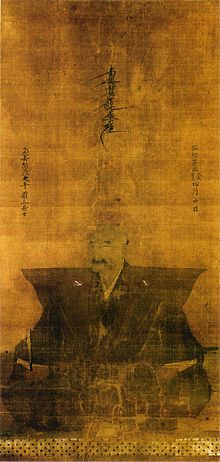Saitō Dōsan
Saitō Dōsan 斎藤道三 | |
|---|---|
 Saitō Dōsan | |
| Head of Saitō clan | |
| In office ?–1556 | |
| Succeeded by | Saitō Yoshitatsu |
| Personal details | |
| Born | 1494 |
| Died | May 28, 1556 (aged 61–62) Battle of Nagaragawa, Mino Province |
| Children | Saitō Yoshitatsu Nōhime |
| Military service | |
| Nickname(s) | "Viper of Mino" |
| Allegiance | |
| Battles/wars | Battle of Kanōguchi (1547) Battle of Nagaragawa (1556) |
Saitō Dōsan (斎藤 道三, 1494 – May 28, 1556), also known as Saitō Toshimasa (斎藤 利政), was a Japanese samurai during the Sengoku period.[1] He was also known as the "Viper of Mino" (美濃の蝮, Mino no Mamushi) for his ruthless tactics.[2] His honorific title from the Imperial Court was Yamashirō-no-kami and since he was a monk he was also called Saitō Yamashirō-nyudō-no-kami.
Biography[]
Originally a monk, he later became a seller of oil. He became a daimyō through gekokujō of Toki Yorinari in Mino Province. The Saito fortress was located at Inabayama.[3][4][5] He married 'Omi no kata', a sister of Akechi Mitsutsuna (Akechi Mitsuhide father).
He defeated Oda Nobuhide at the Battle of Kanōguchi in 1547.[6]
However in 1549, eventually Dosan was defeated by Oda Nobuhide, Nobuhide made peace with Dōsan by arranging a political marriage between his son and heir, Oda Nobunaga, and Dōsan's daughter, Nōhime. Dōsan, therefore, became the father-in-law of Oda Nobunaga.[1][3] Dōsan supported the marriage which allowed Nobuhide to focus on facing Imagawa Yoshimoto.

Death[]
Rumors had started to circulate that Dōsan's firstborn son, Saitō Yoshitatsu, was not his natural son and Dōsan started to consider another son, Kiheiji, or even his son-in-law Oda Nobunaga, as his heirs. This caused Yoshitatsu to rebel and kill his two younger brothers. In 1556, the forces of Dōsan and Yoshitatsu clashed in the Battle of Nagara-gawa which resulted in the death of Dōsan.[1][3]
Dōsan's head was taken by a man called Komaki Genta, a retainer of Yoshitatsu's son Saitō Tatsuoki. His remains were originally interred in Sōfuku-ji, but they were later moved to Jōzai-ji because the Nagara River kept overflowing and covering his burial mound.[7] Both temples are located in the city of Gifu which celebrates Dōsan with an annual festival.[8]
Pseudonyms[]
Saitō Dōsan is known for having a large number of pseudonyms and for frequently changing his name. Some believe that this is because there were two Saitō Dōsan, father and son, and the son adopted his father's name after his death. Other names of Saitō Dōsan are Minemaru (峰丸), Hōrenbō (法蓮坊), Matsunami Shogorō (松浪庄五郎), Nishimura Kankurō Masatoshi (西村勘九郎正利), Shinkurō (新九郎), Nagai Norihide (長井規秀), and Saitō Sakondayu Toshimasa (斎藤左近大夫利政). The name Saitō was adopted from the former shugodai of Mino who had been overcome by the in the 1520s.[citation needed]
Family[]
- Father: (in one traditional story; another version says that he was child of , a monk of )
- Wife: , daughter of
- Concubine: Miyoshi no Kata
- Children:
- Saitō Yoshitatsu born to Miyoshi no Kata
- Saitō Magoshirō
- Saitō Kiheiji
- Saitō Toshitaka
- Saitō Nagatatsu (Toshiharu)
- Nōhime (Kicho)
See also[]
References[]
- ^ Jump up to: a b c Nussbaum, Louis-Frédéric. (2005). "Saitō Dōsan" in Japan Encyclopedia, p. 809.
- ^ Glenn, Chris (May 28, 2015). "The Viper of Mino, Saito Dosan". Japan World.
- ^ Jump up to: a b c Turnbull, Stephen (1987). Battles of the Samurai. Arms and Armour Press. p. 57. ISBN 0853688265.
- ^ Sengoku Bushō Retsuden 12: Saitō Dōsan Archived 2012-03-30 at the Wayback Machine. Accessed September 20, 2007.
- ^ Buke Kaden - Mino Saitō-shi. Harimaya. Accessed September 20, 2007.
- ^ Turnbull, Stephen (1998). The Samurai Sourcebook. Cassell & Co. p. 211. ISBN 1854095234.
- ^ Gifu City Walking Map. Gifu Lively City Public Corporation, 2007.
- ^ "Dosan Festival". Visit Gifu. Gifu Prefecture Tourism Federation. Retrieved 6 September 2021.
- 1494 births
- 1556 deaths
- Daimyo
- Japanese warriors killed in battle
- Saitō clan